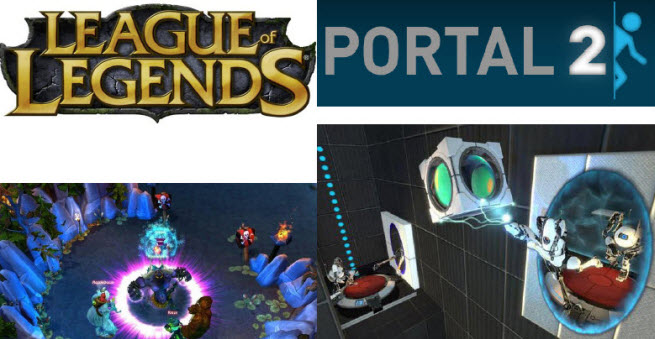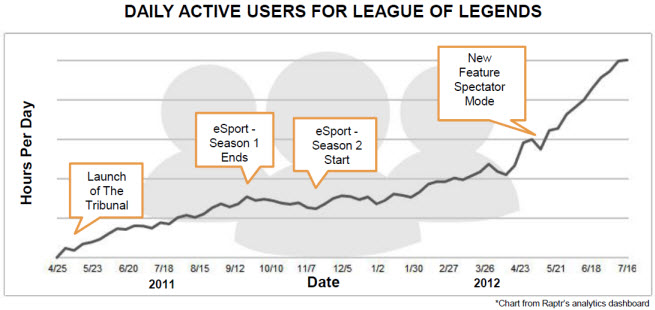It’s the community, stupid.
 Game publishers may wonder what it takes to get loyal users. Well, the trick is obvious, according to gamer social network Raptr: You have to create a great game. Then you build a community around that game that generates goodwill among gamers. And that translates into better user engagement, revenues, and profits.
Game publishers may wonder what it takes to get loyal users. Well, the trick is obvious, according to gamer social network Raptr: You have to create a great game. Then you build a community around that game that generates goodwill among gamers. And that translates into better user engagement, revenues, and profits.
Most companies are using their analytics and data about gamers’ preferences to milk them for all they’re worth. They want to target gamers with services and goods that the players will pay for. But that’s a shortsighted approach, and the games-as-a-service business model isn’t as complete as the community-as-a-service approach, says Dennis Fong, the chief executive of Raptr.
“Games-as-a-service has a lot of rhetoric, but it’s mostly about monetizing the user,” he said. “In our view, it’s a missed opportunity. It’s really a chance to build a long-term relationship with the user.”
And Fong has some data to back up his beliefs in a new Raptr Report, which is mined by Raptr’s community of nearly 15 million gamers. The data show that it really does pay to establish trusted relationships with players through community services (which appear to cost money), such as livestreaming, eSports events, loyalty programs, or free modification tools.
Most companies don’t see the light here. They realize that giving to the community generates goodwill, but they worry about the cost and the impact on monetization.
“If you take a player-first approach, it’s good for business,” said Fong. “Companies need to do more, and we have the data to show why.”
Case study: Portal 2’s map creator
A good example of putting the community first is Valve’s recent behavior. In April 2011, Valve launched its big hit, Portal 2. The game was popular, but it had low replayability. In May 2012, Valve released its free map-creation tool that let players create their own maps and share them. Players created an astounding 35,000 levels, which were downloaded 1.3 million times during the first week after the launch of the mod tools.
Portal 2 saw an 806 percent increase in daily active users (the number of users who play a game in a day) the day after the tools were out. A month later, there were still 40 percent more people playing the game daily compared to before. Valve saw a 2,218 percent increase in new users. After release of the tools, they accounted for 18 percent of all daily active players. A month later, Portal 2 still had 28 percent more new users than before. Portal 2 also saw a 1,113 percent increase in bringing back lapsed players the day after the release; about 46 percent of all daily active users were returning lapsed players. A month later, there were still 15 percent more returning players than before.
The average daily playtime per user grew 36 percent from 1.4 hours to 1.9 hours per day. A week after release, people were still playing 29 percent longer per day than before. A month later, playtime was 17 percent higher. Valve’s goal was simply to extend the life of the game for existing players, said Fong. But the actual impact was clearly far greater.
Case study: DayZ user-generated mod breathes life into Arma II
A second example is from the military shooter game Arma II, which Bohemia Interactive released in May 2009. The game wasn’t particularly successful, with flat sales after its launch. Then one of the designers at Bohemia decided to create a zombie-themed mod of Arma II as a proof of concept for a game he wanted to create. Within a month after the release of the DayZ mod, sales for Arma II spiked 400 percent to 300,000 units. Within four months, more than 1 million gamers had played DayZ.
A week after DayZ’s release, Arma II daily active users were up 36 percent. But the game gained momentum over time. A month after release, daily active users were up 847 percent. The Dayz mod brought in a 1,343 percent increase in new players in a month. These players accounted for 15 percent of all daily active users in the first month. Returning users were up 20 percent in the first week and 101 percent in the first month. Players also spent 36 percent more time in the game, from 2.2 hours per day to 3 hours per day. The week after launch, players played 23 percent more than before.
“It was like they created a whole new game,” said Fong.
Case study: Riot Games gets players engaged even when they aren’t playing
League of Legends took off in October 2009 as Riot Games published the free-to-play fantasy multiplayer online battle arena game. The title grew steadily to tens of millions of players. On average, League of Legends grows its user base by 7.6 percent each month.
But by turning the game into an eSport, or a spectator sport that was broadcast online, Riot Games was able to bring a consistent boost to the audience. The MLG eSports finals and the Dreamhack competitive event boosted player activity from 3 percent to 10 percent in daily active users. Overall, playtime was up 3 percent to 8 percent following the events. New player rates jumped 10 percent, and returning players were up 12 percent. The League of Legends Season One finals drew 241,000 peak concurrent online viewers, who watched more than 3.6 million hours of video.
“No one really knows if a holding a tournament is good for a game,” said Fong. “We dug into it and found it was true.”
The stats go on and on
Of course, you would expect Raptr, a social network for gamers, to say that social work pays off. Fong said that when Blacklight: Retributions developers engaged the Raptr community in a long question-and-answer session, the number of daily active players increased by 10 percent and playtime increased 19 percent. Players asked 1,600 questions and viewed 60,000 pages during the session.
Fong says it’s critical to know who the loyal players are, where they come from, and what their habits and behaviors are in the game. OGPlanet launched a loyalty program with Raptr Rewards (where brands give rewards to players who play a game a lot). The program helped increase daily playtime per Raptr user by 97 percent. The game saw a 400 percent increase in new players and a 180 percent increase in returning players on the first day of the program.
The conclusion should be clear: Don’t just milk your users. Give them what they want, and they will pay you back many times over.
“Lots of companies treat community as an afterthought or a charity,” said Fong. “It’s a huge missed opportunity.”
VentureBeat's mission is to be a digital town square for technical decision-makers to gain knowledge about transformative enterprise technology and transact. Learn More




